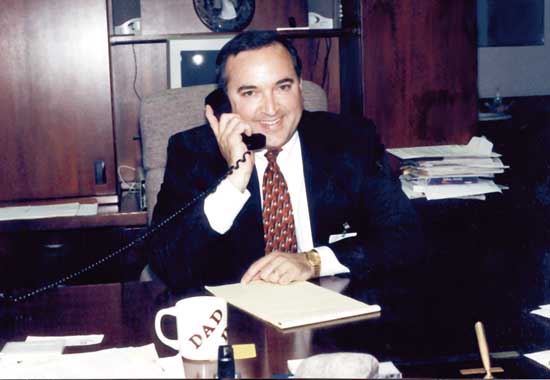
Streamlined Northeastern
hails new era
In its second year as part of the Temple University health system, venerable Northeastern
Hospital is a streamlined medical facility offering new services for the residents of the lower
Northeast.
BY DAVID J. FOSTER
Staff Writer
The Temple University banners that wave along Allegheny Ave. send two messages: The
pride and the hospital are back.
Two years ago, isolated in this era of mergers and multi-hospital systems, Northeastern
Hospital, Allegheny Ave. and Tulip St., was a dinosaur, a stand-alone acute care facility
struggling to treat an aging community with increasingly complex health needs.
Back in the 60's and 70's when its patient mix was younger and medical care less
bureaucratic, technical, and costly, "Northeastern was the place too," said Jeffrey Susi, the
hospital's new CEO.
Twenty years later, merger-mania and the aging of the local population made for some
very difficult times. Survival was not guaranteed.
"Word spread quickly," Susi said. "This is a very close knit community."
That community Port Richmond was home to Northeastern's patient base. If they turned
away, it was all over.
Port Richmond hasn't changed much over time. Still middle class and largely blue collar,
its residents' roots are deeply planted along Frankford and Allegheny aves. It's how they've
warded off much of the blight suffocating its neighboring communities. These are loyal, scrappy
people.
"There was always a solid group of people who supported Northeastern," said Susi. But
they are also attentive tony changes in their community.
"You can spend a fortune on marketing, but it's the word-of-mouth marketing people's
perceptions and what they tell one another that's everything here," said Susi.
And when the community perceived Northeastern as suffering under the crush of hospital
mergers and expansions, even the employees grew anxious.
The January 1995 acquisition by Temple University gave residents pause: "The attitude
was, 'Gee, that's great, I think.' They feared (we would) still close and transfer the patients (to
Temple)," said Susi, who arrived a year later.
But Temple backed their promises with money. Two years later, Temple has invigorated
Northeastern with millions of dollars in services, medical expertise, and cash.
Those new problems have made the change palpable to the hospital board, the
surrounding business community, and that core group of Northeastern patients.
It's that patient base that enticed Temple. Prior to the acquisition of Northeastern, local
cardiac patients would utilize any one of three facilities (Temple University Hospital, Allegheny
University Hospital, or Albert Einstein Medical Center). No longer. "Now, Temple receives the
lion's share" of the patients, said Susi.
Susi says that while Temple brought much to Northeastern, cooperation with
management by physicians, nurses, and employees have also played a major role in the rebirth.
"Four years ago, 40 percent of Port Richmond (patients) needing orthopedic surgery
would have gone downtown. Now, we have a daily room dedicated just to orthopedics - two
rooms on Friday," said Susi. Northeastern's orthopedics business has doubled. The surgeons are
members of Temple's top flight orthopedic team.
One year ago, Northeastern opened a sports medicine facility. "That's something we
couldn't have done without Temple," Susi said.
Temple is renown for guiding the city's top athletes back to peak performance after
severe and complicated injuries. "Why can't Aunt Bessie use the same knowledge and approach
to return to her highest level of performance? The concepts used in sports medicine can help the
hip replacement patient become mobile again," said Susi.
In keeping with its dedication to me aging population, Northeastern has added a 20-bed
extended care unit where patients can stay two weeks beyond what their insurer will allow.
Other programs targeted to the elderly: Home health services and adult day care.
The next big advance for the hospital will be in the area of pulmonary care.
"Port Richmond has high incidents of smoking and environmental-related lung and
airway problems," Susi said. "The first thing we will do is get the staff of Temple pulmonology
over here to see patients."
Northeastern is also examining the possibility of adding a lung and airways disorder
center, which would house a sleep laboratory. A cancer treatment center is not far behind.
The union with Temple also played a critical role in helping Susi reduce costs. For
example, Northeastern's food services have been consolidated with Temple's. "Half the
preparation is done on-site, half is done at Temple," Susi said. Next on the agenda: consolidating
laboratories. Estimated savings: $500,000.
"For the things we will never be able to do here, we have easy access - a doorway - into
Temple University," Susi said. "That means all their information and their relationships with
primary care doctors flow with them."
And if they can't get to Temple on their own, Northeastern runs a shuttle service to get
them there.
"We've always been a community hospital providing health services to the community.
Now we can deliver University level services locally to that community," said Susi.
| 

 Go back to the News page
Go back to the News page Please e-mail us with any comments or suggestions
Please e-mail us with any comments or suggestions Go to the News Gleaner Homepage
Go to the News Gleaner Homepage Find out how to reach us
Find out how to reach us